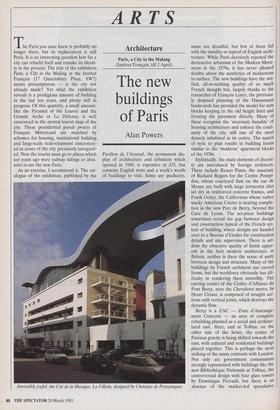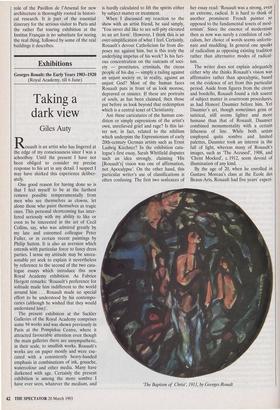ARTS
Architecture
Paris, a City in the Making (Institut Francais, till 2 April)
The new buildings of Paris
Alan Powers
The Paris you once knew is probably no longer there, but its replacement is still Paris. It is an interesting question how far a city can rebuild itself and remake its identi- ty in the process. The title of the exhibition Paris, a City in the Making at the Institut Francais (17 Queensbury Place, SW7) seems presumptuous — is the city not already made? Yet what the exhibition reveals is a prodigious amount of building in the last ten years, and plenty still in progress. Of this quantity, a small amount, like the Pyramid of the Louvre and the Grande Arche at La Defense, is well ensconced in the mental tourist map of the city. These presidential grands projets of Francois Mitterrand are matched by schemes for housing, institutional building and large-scale redevelopment concentrat- ed in zones of the city previously unregard- ed. Now the tourist must go to places which ten years ago were railway sidings or abat- toirs to see the new Paris.
As an exercise, I recommend it. The cat- alogue of the exhibition, published by the Pavillon de ('Arsenal, the permanent dis- play of architecture and urbanism which opened in 1988, is expensive at £35, but contains English texts and a week's worth of buildings to visit. Some are nediocre, Irresistibly joyful: the Cite de la Musique, La Villette, designed by Christian de Portzamparc some are dreadful, but few of them fail with the timidity so typical of English archi- tecture. While Paris decisively rejected the destructive urbanism of the Modern Move- ment in the 1970s, it has never allowed doubts about the aesthetics of modernism to surface. The new buildings have the uni- fied, all-or-nothing quality of so much French thought but, largely thanks to the researches of Francois Loyer, the previous- ly despised planning of the Haussmann boulevards has provided the model for new blocks keeping to the old height limit and fronting the pavement directly. Many of these recognise the 'necessary banality' of housing architecture and enforce the conti- nuity of the city, still one of the most densely inhabited in its centre. The match of style to plan results in building forms similar to the `moderne' apartment blocks of the 1930s.
Stylistically, the main elements of diversi- ty are introduced by foreign architects. These include Renzo Piano, the associate of Richard Rogers for the Centre Pompi- dou, whose courtyard flats on the rue de Meaux are built with large terracotta tiles set dry in reinforced concrete frames, and Frank Gehry, the Californian whose rather wacky American Centre is nearing comple- tion in the new Parc de Berg, beyond the Gare de Lyons. The set-piece buildings sometimes reveal the gap between design and construction typical of the French sys- tem of building, where designs are handed over to a Bureau d'Etudes for construction details and site supervision. There is sel- dom the obsessive quality of finish appar- ent in the best modern architecture in Britain, neither is there the sense of unity between design and structure. Many of the buildings by French architects use curved forms, but the workforce obviously has dif- ficulty in rendering them smoothly. The curving corner of the Centre d'Affaires du Pont Bercy, near the Chevaleret metro, by Henri Ciriani, is composed of straight sec- tions with vertical joints, which destroys the dynamic flow.
Bercy is a ZAC — Zone d'Amenage- ment Concerti — an area of complete rebuilding planned as a social and architec- tural unit. Here, and at Tolbiac on the other side of the Seine, the centre of Parisian gravity is being shifted towards the east, with cultural and residential buildings placed together. This is perhaps the most striking of the many contrasts with London. Not only are government commissions strongly represented with buildings like the new Bibliothique Nationale at Tolbiac, the controversial design with four glass towers by Dominique Perrault, but there is an absence of the market-led speculative office development which imposed the law of the jungle in our own Docklands and in the City of London. The importance given to dwelling is emphasised when one sees washing being hung out on the balconies of the new Cite de la Musique bordering the Parc de la Villette. Designed by the archi- tect Christian de Portzamparc, this building is irresistibly joyful with a waving canopy and a well-judged use of colour and curved form. Opposite stand new apartment blocks by the Italian architect Aldo Rossi which fully justify the study of traditional city form begun by Rossi in the 1960s, with the traditional curved zinc mansard and street level arcade re-used by Rossi in typi- cal reminiscence of Italian metaphysical painting.
The Parc de la Villette is an astonishing set-piece, based on the canal extending north-east from Ledoux's neo-classical Bar- riere at Stalingrad metro. It contains a sci- ence museum, theatre, exhibition hall and a lot of red buildings by the American deconstructivist architect Bernard Tschumi, referred to as folies. These are engaging and not necessarily useless (one is a burger restaurant). They span architecture and sculpture and pop up on a grid across the park, interspersed with gardens like a mist garden with jets of spray. La Villette is Clearly hugely popular with adults and chil- dren, a model for a modern urban park.
The contrasts with London are too numerous and too depressing to make. We have good modern buildings, but not always where they are needed. The price of our valuable architectural pluralism is too often compromise and confusion. The sense of urban strategy, which is reinforced by the historical analysis of the exhibition catalogue, is paramount in Paris and so lacking in London that a site of European Importance like the King's Cross goods Yard looks like remaining useless beyond the end of the century. Somerset House, the most Parisian building from Georgian London, still has no clear prospect of becoming devoted to cultural uses. If Lon- don were Paris, the site to the rear of the British Library would already be filled with housing as the focus of a new quartier. When an imaginative development like Butler's Wharf is achieved, the economic consequences discourage imitation.
It goes almost without saying that the difference is primarily political. Without state and city funding and control, the rebuilding of Paris could have been as opportunistic as London. Even now, we have the spectacle of the chairman of English Heritage dismantling his own Lon- don Region, one of the most valuable sur- viving components from the GLC, which offers scholarship, control and expertise for listed buildings in the capital. The London Region could instead become the basis for a London 'Architecture Centre', such as is now desired in emulation of the Pavillon de ]'Arsenal. Organising exhibitions and pub- lishing large catalogues, the propaganda
role of the Pavillon de l'Arsenal for new architecture is thoroughly rooted in histori- cal research. It is part of the essential itinerary for the serious visitor to Paris and the rather flat touring exhibition at the Institut Francais is no substitute for seeing the real thing, followed by some of the real buildings it describes.




























































 Previous page
Previous page